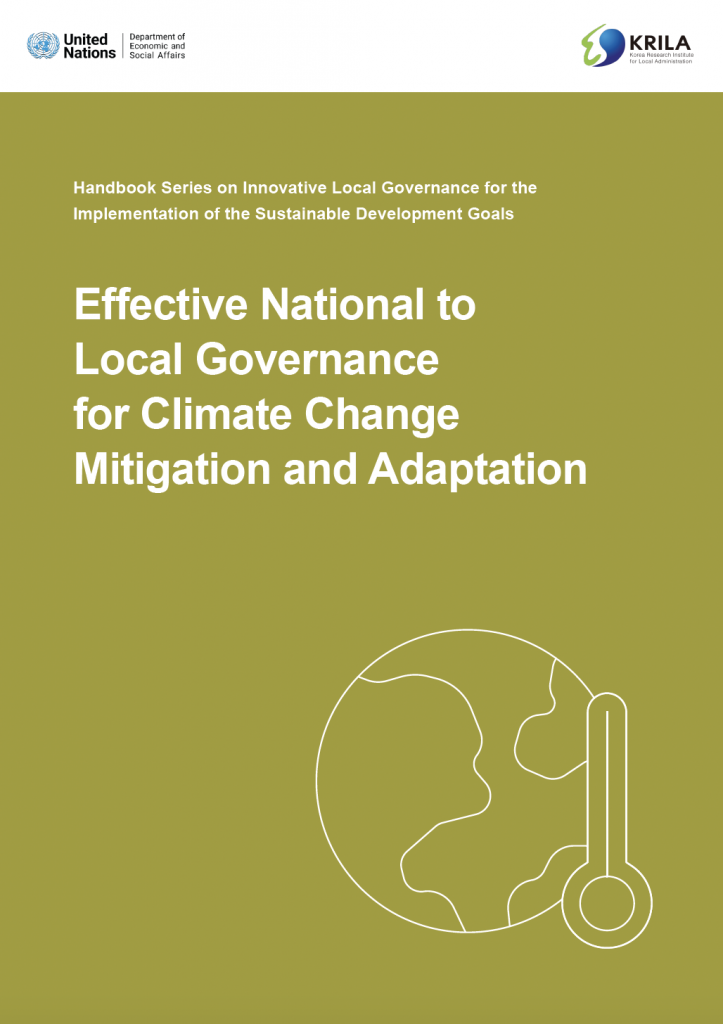This handbook aims to:
– introduce diverse specific strategies, approaches, and policy tools to address climate change (to enhance one country’s capacity and readiness on national to local governance)
– assist local governments with mainstreaming the relevant policy frameworks and strategies for climate change mitigation and adaptation
– strengthen the capacity and readiness of local governments to promote climate change mitigation (with a particular emphasis on fostering the capabilities and skills to engage with diverse stakeholders in the policy processes)
– introduce good and innovative practices of promoting local governance for climate change mitigation and adaptation and assist local government and relevant stakeholders with identifying the areas for improvement and the possible modes and mechanisms of government interventions, where possible, in partnership with the private sector
– provide recommendations for concrete policy actions by local governments and other relevant stakeholders
– provide visibility to relevant transversal aspects, including:
+ Gender-related matters (SDG 5)
+ Focus on North Africa, Asia and the Pacific, particularly the most vulnerable Pacific Islands.
+ Relevant sectors such as infrastructure, ICT, buildings, energy (SDG 7) and transport.
This handbook initially addresses the role of local communities in effective governance for climate action within global frameworks. It then guides local communities to effective governance by considering the following themes:
Multi-level Governance for Climate Change Mitigation and Adaptation (Chapter 3): This chapter explores the transformative leadership paths toward local governance, includes the global/international contexts involving governance for climate action to help the reader understand the big picture, and links national duties and plans and commitments with the local scope. Understanding climate change policy through this multi-level governance approach helps to break down state-centric understandings and to better characterize the relationships between actors at different levels of government.
Institutional Arrangements and Readiness (Chapter 4): This chapter examines organizational structures and processes and shares roadmaps, standards, governance approaches and smart policy toolkits designed to evaluate current local climate action efforts and paths forward toward established goals.
Policy Coherence and Local-National Climate Policy Linkages (Chapter 5): This chapter explains the need to integrate the existing initiatives with the national/local SDG plans in order to build a coherent system. Mechanisms are provided to anticipate, balance and reconcile divergent policy pressures and opposing economic, social and environmental concerns. Reconciling competing sectoral interests, short-term priorities and long-term policy direction also are addressed.
Multi-stakeholder Engagement (Chapter 6): This chapter guides the reader on how to proactively engage stakeholders to achieve powerful and inclusive climate action planning.
Monitoring and Evaluation and Reporting (Chapter 7): This chapter shares how to bring rigor and structure into efforts to measure progress in achieving mitigation goals. Obtaining a baseline for monitoring the progress of initiatives and accountability is highlighted. Both help ensure that promised results are being achieved.
Conclusion: Summary and Policy Recommendations (Chapter 8): Based on the aspects discussed in previous chapters, this chapter provides policy recommendations for concrete actions by the local governments and other relevant stakeholders.
For each thematic chapter, additional reference materials are provided, including readings, cases, tools and exercises.
Effective National to Local Governance for Climate Change Mitigation and Adaptation.pdf





